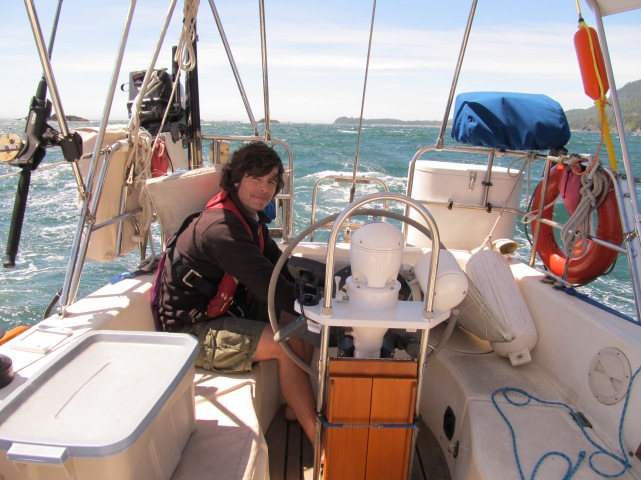Let’s pretend for a moment…you’re out in 20 to 30 knots of wind on a gorgeous, sunny day. The seas are 3’ to 5’, and you are sailing under only a seriously reduced foresail through a reef strewn passage. You’ve ducked into the passage to get some respite from the conditions outside – an exhilarating but somewhat scary 3 hour passage with the biggest, steepest seas you’ve ever seen. You’ve made a habit of pushing the boat and yourself over the last 10 years of serious cruising, but these seas were big and steep. Dealing with them was hard work and a little stressful. The conditions in the passage are much easier, but the boat is still moving quickly. The closest reef has the surf breaking on it about 250m off your starboard bow, the second closest is dead ahead, about 300m away. There is no missing them – they are a cauldron of raging whitewater. The fairway between them should be easy to navigate, but you need to watch what you’re doing. You’re doing an easy 6 knots through the water, and really enjoying yourself now that those monster seas are gone. You’re thinking about dropping the hook, kicking back and sharing stories. The anchorage is an easy ½ hour away.
Then you lose your steering. At first you can’t believe it because you’re so careful to maintain the boat, but a free spinning wheel is proof. At 6 knots you’ll be on the reef in a couple of minutes. You’re in 70’ of water, so you think about anchoring, but realize that stopping a 10 ton boat doing 6 knots with the anchor is probably impossible in the space available. Do you know where your emergency tiller is? Does it work? If you own a tiller steered boat, do you have a plan – tillers do break. If you can’t answer yes to these questions, chances are excellent you have 2 minutes before you’re on the rocks with the surf breaking on you, pounding you and your boat as you try to survive. There is a chance you will lose your boat. There is a chance that you will not survive. Do you know where your emergency tiller is? Does it work? We’re incredibly lucky. We did, and it worked. The calm anchorage was amazing.
Some notes on cable steering:
Many people don’t even think about their steering system. We’d ignored it for 8 years, and had no idea when the previous owner serviced it. Much like when we drive, we just expect it to work. Edson – a major manufacturer of sailboat steering systems – recommends an annual inspection. (see http://www.edsonmarine.com/support/PDFs/inspection/EB372SteeringInspection.pdf). Cables showing any signs of wear (ie: “meathooks” or broken strands) need to be replaced. Parts should be lubricated regularly, including the sprocket and other parts below the binnacle compass. All of this equipment is probably installed in the least accessible part of your boat – not much fun. When you replace your cables, make sure to install the cable clamps so that the U-bolt is bearing on the tail, not the standing part of the cable. (see http://www.worksafenb.ca/docs/e_Safetytalk15.pdf) Use 3 clamps on each side, and make sure they are TIGHT (there is are torque specs on the pdf). This is where ours failed. When I went to fix the system, I found both clamps that I’d installed sitting on the hull directly beneath the quadrant. I hadn’t tightened them enough. At least it a relatively easy fix that we made while on the hook behind an island not far from where we lost steering. We added a third clamp to each cable at the next port.

